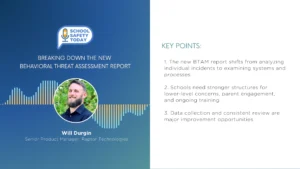New Report Reveals Urgent Need for Off-Campus Internet
While E-rate remains a crucial program for schools and libraries to ensure connectivity, the COVID-19 pandemic brought attention to the need for increased flexibility and funds for off-campus learning.
In the 10th annual E-rate Trends Report, based on with a record-breaking 2,138 responses submitted by E-rate applicants, Funds For Learning offers an inside look at the efficacy and value of the federal E-rate program.
“The importance of having fast, reliable internet access for schools and libraries has never been clearer,” writes John Harrington, CEO of Funds For Learning, in the report’s intro. “As a result of the COVID-19 pandemic, communities now have a much deeper appreciation for the significant role that broadband communication plays in educating students and connecting our citizens. K-12 schools and public libraries are at the front lines of providing access to online resources, and they rely on the E-rate program to provide most of the financial support for their Internet connections.”
Key 2020 report findings include:
1. Off-campus internet is an ascendant issue for schools, communities and parents. Ninety percent of respondents report that insufficient internet access is a significant issue in their communities, and 93 percent report that they would share their discounted internet access off-campus if allowed by the FCC.
2. Emergency relief funding was not largely utilized to close the digital divide during the pandemic; the E-rate program is viewed as a viable mechanism to fund off-campus connections–58.6 percent of respondents did not use or were unable to use the Emergency Stabilization Fund for expenses necessary to support off-campus internet access for remote learning. Moreover, 82.5 percent of respondents agree or strongly agree that their schools and libraries would use the E-rate program for off-campus connections.
3. The administration and efficiency of the E-rate program has improved. The majority of respondents are satisfied with the administration of the program by USAC and the EPC tool that enables applicants to file for E-rate funding.
4. The modernization of the E-rate program was successful, and there continues to be increased demand in C2 services. Seventy-five percent of respondents agree or strongly agree that they would be applying for discounts on Category Two services in FY2021.
5. E-rate remains a vital program for schools and libraries to achieve connectivity goals. Ninety percent of respondents agree or strongly agree that schools and libraries connect more students at faster speeds due to the E-rate program.
6. Nearly all survey participants say they believe cybersecurity should be eligible for E-rate funding, with 98 percent agreeing with the idea in 2020 compared to 96 percent in 2019 and 2018.
7. Most schools and libraries will increase their internet bandwidth by at least 50 percent over the next three years, with an average annual increase of 17 percent reported by respondents.
8. Open-ended comments highlighted the desire for internet hot-spot funding, particularly among rural and low-income school communities. “In light of the current and ever changing circumstances it is vitally important that E-rate funds/programs be allowed to be used for hot spots to help enable rural schools to connect students from home where it is impractical and unsafe to get to a Wi-Fi spot,” said one survey respondent. “I would like to see Cybersecurity software and hardware tools protecting our network/users, and Internet Hot Spots for needy families to be eligible for E-rate. Thank you,” write another.
Participation in this year’s survey was at an all-time high with 2,138 responses counted, which is equivalent to 9.9 percent of all FY2020 E-rate applicants.
“As the past few months have so poignantly demonstrated, an online connection should never be taken for granted. Internet access plays a central role in our society, and schools and libraries are at the forefront of making sure our communities are included online,” Harrington says. “The annual E-rate survey amplifies our combined voices to affect positive change for the program; we’ll continue calling upon Congress to leverage the E-rate program for equitable off-campus internet connections.”
Findings from the report will aid and inform key policymakers and administrative members in maintaining the value of the E-rate program, and adapting funding to meet stakeholder needs. To learn more about Funds For Learning’s mission to ensure connectivity for all students, click here.
Twitter – @MarketScale
Facebook – facebook.com/marketscale
LinkedIn – linkedin.com/company/marketscale








